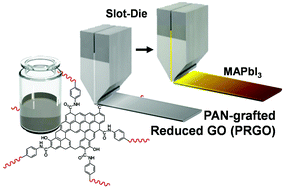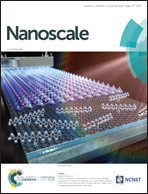Structural design considerations of solution-processable graphenes as interfacial materials via a controllable synthesis method for the achievement of highly efficient, stable, and printable planar perovskite solar cells†
Abstract
Solution-processable graphenes (represented by reduced graphene oxides, rGOs) have shown promising abilities as HTLs in perovskite solar cells (PeSCs). However, there has been no attempt to systematically tailor the characteristics of rGOs to the specifications of PeSCs. Furthermore, the applications of rGO HTLs have been limited to the spin-coating system, which is incompatible with roll-to-roll manufacturing. Here, with the aid of a polymer–graphene hybrid structure and a controllable synthesis method, we successfully developed a much more feasible rGO HTL and demonstrated highly efficient, stable, and printable p–i–n planar PeSCs with facile one-step processing. The characteristics of the developed polyacrylonitrile-grafted rGOs (PRGOs) were optimized by varying the synthesis conditions including the γ-radiation intensity (200, 400, and 600 kGy) and the concentration of the acrylonitrile (AN) precursor (2, 4, and 6 wt%). It is revealed that the PRGO synthesized with a lower AN concentration and a higher irradiation intensity (PRGO_2-600) is the most suitable one for PeSC HTL. PRGO_2-600 effectively raises the average power conversion efficiencies (PCEs) of PeSCs by ∼36% compared to those of conventional PeSCs using PEDOT:PSS HTL. The comprehensive investigations confirm that the enhanced device efficiency stems from (1) the favorable interlayer characteristics of the PRGO itself and (2) the well-crystallized perovskite layer grown on the PRGO. In addition to the PCE, thechemically inert PRGOs can also maintain their electrical properties over time and retard the decomposition of perovskite films, thereby prolonging the operation time of PeSCs in the atmosphere. More importantly, the applicability of the PRGO HTL is clearly verified even in the roll-to-roll compatible slot-die coating system, exhibiting comparable performances to those of the spin-coating system.



 Please wait while we load your content...
Please wait while we load your content...